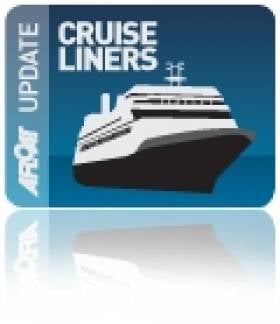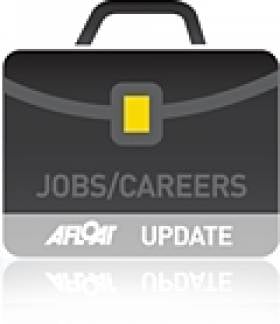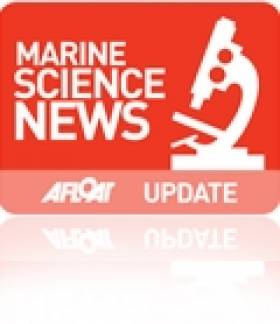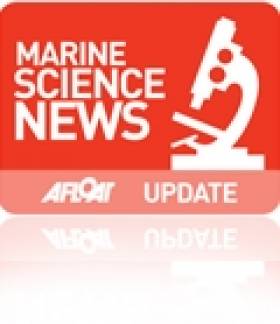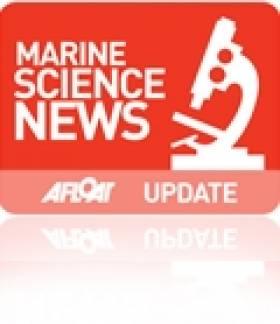Displaying items by tag: marine science
Sea Trout Experts To Gather In Dundalk For International Symposium Next Month
#MarineScience - The second International Sea Trout Symposium will take place in Dundalk, Co Louth from 20-22 October, as previously reported on Afloat.ie.
Building on the success of the previous symposium on the biology, conservation and management of the important fishing species, held in Cardiff in 2004, next month's convention will bring together fishery scientists, managers, policy makers and other interested parties to discuss developments over the last 11 years, identify strategic gaps in knowledge and review priorities for future investigation.
Inland Fisheries Ireland's (IFI) head of research Dr Cathal Gallagher says: “This is a great opportunity for all those interested in the ecology, management and conservation of sea trout to interact with the leading international scientists, managers and policy makers working in this area.
"It is hoped that the outputs from this important symposium will help to drive Ireland’s policy for the future management of our sea trout populations.”
Dr Ciaran Byrne, IFI chief executive, added that the symposium "gives us an important opportunity to review the progress in improving our understanding of biology, ecology, genetics and behaviour of sea trout [since Cardiff] and to identify knowledge gaps required to support the future management of this important species.”
For more information visit www.fisheriesireland.ie
Applications Open For Explorers Marine Education Programme In 2015-16
#MarineScience - Applications are now open for primary schools that wish to take part in marine-related activities and workshops for the 2015-16 school year as part of the Explorers Education Programme.
The programme's new module system, introduced in 2014, "allows for more students and teachers to get involved in marine projects, seashore safaris, having aquariums in the class, or taking part in a number of exciting marine workshops at their local education centre or at Galway Atlantaquaria," says Cushla Dromgool-Regan of the Marine Institute.
These modules include:
- Explorers Aquarium in the Classroom: This involves students running a saltwater aquarium of native species for up to four weeks in their classroom.
- Explorers Marine Project: Students will carry out a marine based project in school. Project topics can include Marine Biodiversity, Marine Litter, or science on the Research Vessel Celtic Explorer.
- Explorers Seashore Safari: Accompanied by the Explorers Education Officer, the students will visit their local shoreline to examine the plant and animal life present and their adaptations to life.
- Explorer Workshops at Galway, Mayo, Clare and Sligo education centres: These workshops will last around two hours and will cover the Real Map of Ireland, marine biodiversity around Ireland, characteristics of living things and a squid dissection. Teachers will be asked to complete one Explorer's lesson plan post visit and a half day visit by an Explorers Education Officer will review this work and recap on the materials covered.
Science workshops will also be available to all Explorers schools at Galway Atlantaquaria between October 2015 and March 2016 at a discounted price of €5 per students for a two-hour workshop. For more information call 091-585100.
Teachers can send their applications to their local education centres in Galway, Clare, Mayo and Sligo highlighting how the Explorers Education Programme will be beneficial to their class, school and community. Applications must be submitted before 4pm on Friday 18 September.
Application forms and additional information about the modules, as well as free teaching materials, are available to download at www.explorers.ie. For any queries relating to the Explorers Education Programme contact [email protected].
The Explorers programme continues to run in Dublin and Cork in association with the Blackrock Education Centre, the National Sea Life Centre Bray and the Lifetime Lab in Cork. More information about their workshops will be issued later in the year.
The Explorers Education Programme is supported by the Marine Institute, and is funded under the Marine Research Programme by the Irish Government.
Deadlines Approaching For Marine Institute Roles
#Jobs - Deadlines to apply for a number of jobs with the Marine Institute are coming up over the next two weeks.
Those interested in the role of Oceanographic Services Manager have until 5pm today (Wednesday 1 July) to submit their applications.
Tomorrow (Thursday 2 July) at 5pm is the closing date for two Team Leader positions, in Data Management and Software Development.
Graduates interested in the role of Economic Researcher should submit their CVs and cover letters by 4pm on Friday 3 July, which is also the closing date for the Cullen Fellowship for PhD students in ocean observation. Applicants for the Communications Stagiaire position have until 5pm on the same date.
Meanwhile, marine science graduates interested in the PhD opportunity in Ocean Colour and Dynamics in the Eastern Atlantic from Satellite Observations (OCEANS) have until 5pm on Wednesday 15 July to submit their applications ahead of interviews commencing the following week.
For the latest vacancies see the Marine Institute website HERE.
Registration Open For International Sea Trout Symposium
#MarineScience - The second International Sea Trout Symposium will take place in Dundalk, Co Louth from 20-22 October 2015.
Targeted at scientists, managers and other fishery stakeholder interests in the public and private sectors, the central aim is to promote the wider application of an evidence-based approach to the future management and regulation of the sea trout and to ensure that its often very special needs become fully integrated into catchment management plans and environmental impact assessments.
This major event will build on the success of the first International Symposium on the ‘Biology, Conservation & Management of Sea Trout’ held in Cardiff, Wales in 2004. Its overall objective will be to promote the application of the latest science to the better management of sea trout stocks and their associated fisheries.
It will consider developments since the previous symposium, highlight the implications of the strategic gaps in our knowledge that currently limit our ability to manage the resource effectively and review priorities for future investigation.
The symposium is aimed at fishery scientists, managers, policy makers and other interested parties. It is planned to provide practical guidance to assist managers and regulators in the sustainable management of the sea trout resource and to ensure that they are fully integrated into any assessment of the impact of other policies, regulations and developments affecting their aquatic environment. While primarily focused on migratory sea trout, it will include non-migratory trout and other anadromous species where relevant.
Symposium topics will include:
- Understanding Anadromy
- Populations & Management
- Movements & Migration
- Ecology & Behaviour
- Monitoring & Surveillance
- Threat Assessment
- Future management and research
Rates for the symposium start at €70 for the daily attendance package, with a basic three-day delegate package priced at €230 and the full package (including the gala dinner and a copy of the proceedings) at €330. A student delegate package for PhD and MSc candidates is available for €150.
The closing date for registrations is 4 September 2015. Details of the programme, accommodation and travel are available at the Sea Trout Symposium website.
#MarineNotice - The latest Marine Notice from the Department of Transport, Tourism and Sport (DTTAS) advises that a wave measuring device has been installed on the seabed at Dingle Fishery Harbour Centre.
The wave study is being carried out by the Marine Engineering Division of the Department of Agriculture, Food and the Marine and is expected to be ongoing until early September 2015, weather permitting.
For safety reasons, mariners are requested to keep a sharp lookout and to proceed slowly and with extreme caution in this vicinity. Fishermen are requested to take great care when dredging near the location of the device and keep a wide berth.
A yellow floating marker buoy with a special mark beacon has been installed to indicate the location of the device. A photograph of what the buoy looks like in the water and the co-ordinates of its placement are included in Marine Notice No 29 of 2015, a PDF of which is available to read or download HERE.
Students Join Marine Institute For Summer Science Placements
#MarineScience - The annual Marine Institute bursary programme gets underway this month with 23 third-level students from academic institutions in Ireland and the UK joining the institute for eight weeks.
Every year up to 150 of third-level students across Ireland apply for the Marine Institute's highly sought-after bursary programme, which is well recognised in the industry as its purpose is to promote future employment opportunities for undergraduates and postgraduates.
"The work experience programme enables students from a wide variety of disciplines to further their knowledge and research in their particular area of interest and it offers the students to expand their professional networks within Ireland and internationally," explained Helen McCormick, senior laboratory analyst at the Marine Institute and co-ordinator of the bursary programme for 2015.
The students will work in a variety of areas including fish and shellfish assessments and surveys, sampling salmon and commercial fisheries in ports, maritime economics, oceanographic equipment modifications and communications.
The placements will provide students with practical and hands-on experience at different locations around Ireland, including the offices and laboratories at the Marine Institute - Galway, Harcourt Street in Dublin and the Burrishoole Catchment at Newport, Co Mayo. Some students will also be located at fisheries ports in counties Cork and Waterford.
The summer bursary programme has been ongoing since the 1960s in the marine science sector and continues to offer a promising gateway into the expanding areas of marine science and research in Ireland.
Dr Peter Heffernan, CEO of the Marine Institute congratulated all successful bursars on this year's programme, saying: "The institute is delighted to support this excellent learning opportunity for Irish students."
Cold Water Corals Growing In Abundance Off Porcupine Bank
#MarineScience - An international team of scientists led by Prof Andy Wheeler of University College Cork have discovered a new habitat for coral in Irish waters – possibly doubling the amount of cold water corals previously thought to exist in the area – while on the Marine Institute's RV Celtic Explorer during the QuERCi survey.
While conducting research on Irish cold water coral reefs, Prof Wheeler investigated a submerged vertical cliff 800m below the sea surface and found it covered in coral.
"The seabed just falls away into a deep chasm. We couldn't wait to take a look down there, using the Holland I remotely-operated vehicle [or ROV] which is equipped with cameras and robotic sampling arms," he said.
Prof Wheeler and his team have been investigating Irish cold water coral reefs for over 15 years. In the deep, cold, dark Atlantic, these corals form reef habitats supporting a diverse and abundant ecosystem.
It was while mapping and inspecting some previously unconfirmed reefs on the edge of the Porcupine Bank Canyon, 300km offshore from Dingle, that the scientists decided to venture further into the canyon itself.
The ROV Holland I was manoeuvred from a 2,100m water depth in the middle of the canyon, up the canyon wall to the coral reefs clustered around the canyon top at 700m water depth. The bottom of the canyon was choked with organic-rich particles flushing down the canyon on the way to the abyssal plain.
"It was like flying the ROV through a snow blizzard," said Dr Chris McGonigle of Ulster University, "but we just pushed up the canyon and it got steeper and steeper and steeper until we faced this vertical cliff face several hundred metres high."
The cliff face, never seen by humans before, was covered in corals and other associated organisms.
"These near vertical habitats hardly feature on maps yet can be hundreds of metres high and extend for tens of kilometres. This is a massive habitat, barely explored, yet full of ocean life", said Dr Agostina Vertino of the University of Milan-Bicocca. "We found many species of coral, sponges, crabs and fish."
Prof Wheeler believes it is "not unfeasible that there is over 100sqkm of coral habitat that was previously unaccounted for."
The coral discovery site has already been designated a Special Area of Conservation due to coral reefs in the vicinity. Yet despite its protection, the international team lead by Prof Wheeler found snagged fishing gear and litter.
"It is a great shame, we are the first people to see this place yet despite of its remoteness there is still evidence of human impacts," he said.
The RV Celtic Explorer is Ireland's state-of-the-art research vessel and has been recently equipped with new seabed mapping sonars giving unprecedented views of the seabed. The ship is also the dive platform for the Holland I ROV.
"The quality of the data that this ship and ROV can now collect is phenomenal," said Dr McGonigle. "We were seeing details on the seabed that a few years ago we could only have dreamed of.
"This increase in data quality will allow us to develop a much greater understanding of the processes controlling the distribution of life in these unique environments."
Congratulating Prof Wheeler and the team on their discoveries, Mick Gillooly, director at the Marine Institute, said "we are delighted to see the recent upgrade of the Celtic Explorer and the ROV Holland's multibeam sonar suite producing such amazing results for this expedition.
"The high resolution images produced are fundamental in helping scientists with their research as well as helping us provide a better understanding our ocean."
#UnderseaMountains - A multi-national team of ocean exploration experts from Europe, USA and Canada led by Thomas Furey, Marine Institute, has revealed previously uncharted features on the Atlantic seabed including mountains and ridges taller than Carrauntoohil, Ireland's highest mountain.
The survey onboard Ireland's national research vessel, the RV Celtic Explorer, is one of the first projects to be launched by the Atlantic Ocean Research Alliance (as previously reported) formed following the signing of the Galway Statement on Atlantic Ocean Cooperation between Canada, the EU and the US in May 2013. Its goals are to join resources of its three signatories to better understand the North Atlantic Ocean and to promote the sustainable management of its resources.
The team from Marine Institute and Geological Survey of Ireland (INFOMAR-national seabed mapping programme), the Fisheries and Marine Institute of Memorial University of Newfoundland, Canada, the United States' National Oceanic and Atmospheric Administration (NOAA), and the Portuguese Institute for Sea and Atmosphere (IPMA), used the latest multi-beam echo sounder
technology on the Celtic Explorer to create high resolution images of dramatic seabed features.
They uncovered 235km2 of iceberg scarred seabed, ancient glacial moraine features, and buried sediment channels on the Newfoundland and Labrador shelf. They charted a 15km long down-slope channel feature on the western Atlantic continental slope, most likely formed by meltwater run-off associated with ice cap grounding during the last glaciation, approximately 20,000 years ago. They crossed the dramatic Charlie-Gibbs Fracture Zone on the Mid-Atlantic Ridge creating a 3D visualisation of a 3.7km high underwater mountain. Continuing eastward a straight asymmetric ridge feature came to life standing proud from the flat seabed over 140km long, peaking at 1108m high, taller than Carrauntoohil.
The ambitious survey route included an area off Newfoundland and Labrador where cold water corals and sponges are known to occur and crossed the OSPAR designated Marine Protected Area in the dramatic topography of the central Atlantic. It also targeted the drop location for the first trans-Atlantic telecommunications cable laid in 1858 between Ireland and Newfoundland, and
set out to groundtruth seafloor features identified through satellite altimetry research in the last two years.
"This survey marks the beginning of an exciting Atlantic research mapping collaboration between the US, Canada and Europe. It shows what can be achieved when we pool our resources, sharing knowledge, infrastructure and technology. And we hope to build on this next year, when Ireland's R.V. Celtic Explorer will be joined by research vessels from Norway and the USA,
and in subsequent years", said Dr. Peter Heffernan, Marine Institute, Ireland.
"Seeing dramatic seabed features reveal themselves for the first time was a real highlight of the survey" said Tommy Furey, Chief Scientist, Marine Institute, Ireland. "We need to better understand the features that make up the ocean seabed. With global population and seafood demand spiralling, we need to map our seabed to define favourable habitats for fishing, key sites
for conservation, and safe navigation for shipping. Map it, manage it, and mind it."
The survey was part funded by the Government of Newfoundland and Labrador which has invested approximately $5 million in RV Celtic Explorer expeditions since 2010 to support fisheries science activities. The vessel had just completed the annual fisheries survey in Newfoundland and Labrador, which provided the opportunity to embark on the trans-Atlantic mapping survey on
the return journey to Ireland.
Results from the Atlantic Transect will be presented at the Harnessing Our Ocean Wealth conference July 10-11th, 2015 in Cork, and at the Seabed Mapping Working Group meeting preceding the event on July 9th.
Trans-Atlantic Mapping Survey Launched
#survey – Today, a multi-national team of European, Canadian, and American ocean mapping experts launch the first trans-Atlantic mapping survey under the Atlantic Ocean Research Alliance.
The survey is one of the first projects to be launched by the Alliance, formed in May 2013 following the Galway Statement on Atlantic Ocean Cooperation, whose goals are to join resources of its three signatories to better understand the North Atlantic Ocean and to promote the sustainable management of its resources.
Under this new era of cooperation on ocean research, Canada's Fisheries and Marine Institute of Memorial University of Newfoundland will use the Irish research vessel, RV Celtic Explorer, to map the seafloor between St. John's, Newfoundland and Labrador, Canada and Galway, Ireland.
The Government of Newfoundland and Labrador has invested approximately $5 million in RV Celtic Explorer expeditions since 2010 to support fisheries science activities. The vessel has just completed this year's fisheries survey and is returning to Ireland providing the additional opportunity for this trans-Atlantic mapping survey.
Together, with scientists from Ireland's national seabed mapping programme, INFOMAR, at the Marine Institute and Geological Survey of Ireland, and the United States' National Oceanic and Atmospheric Administration (NOAA), and the Portuguese Institute for Sea and Atmosphere (IPMA), the team will use multi-beam echo sounders onboard the vessel to collect ocean mapping data during the transect.
The team will gather information on the physical characteristics of the seafloor, such as water depth, hardness, roughness, and the presence of geohazards. The structure and composition of the near subsurface are key considerations for shipping safety, development-related seabed engineering and sustainable fisheries. The survey will broadly follow the great circle route between Ireland and Newfoundland where the first trans-Atlantic cable was deployed in 1857. The team hopes to map the location where the cable was dropped in the mid-Atlantic, which happened to coincide with the most dramatic topographic feature in the North Atlantic, the Charlie Gibbs Fracture Zone.
"The North Atlantic Ocean is crucial to the ecological, economic, and societal health and resilience of North America, Europe and the Arctic regions and the data we collect will be vital to understanding how we move forward together to ensure its sustainability," said Glenn Blackwood, vice-president, Memorial University (Marine Institute). "We are pleased to lend our ocean mapping expertise in this field and contribute in such a meaningful way for our shared benefit."
"We are happy to see Canadian federal, provincial and academic participation in the Atlantic Ocean Research Alliance," said the Honourable Gail Shea, Canada's Minister of Fisheries and Oceans. "The contribution of so many Canadian scientific experts in this important international initiative demonstrates Canada's commitment to the Atlantic Ocean and the Galway Agreement."
"We are proud to be part of the first trilateral expedition under the Atlantic Ocean Research Alliance," said Kathryn Sullivan, U.S. Undersecretary of Commerce for Oceans and Atmosphere and NOAA administrator. "By collaborating fully within this agreement, we will contribute essential scientific knowledge and ensure our shared Atlantic Ocean remains healthy and productive."
"This is an exciting opportunity to identify some important sites on the Atlantic seabed. It marks the beginning of an Atlantic research mapping collaboration between the US, Canada and Europe. We hope to build on next year in 2016 and subsequent years when Ireland's RV Celtic Explorer will be joined by research vessels from Norway and the USA", said Dr. Peter Heffernan, Marine Institute, Ireland.
Speaking at the announcement of the survey in Brussels in April 2015, Simon Coveney, Irish Minister for Agriculture Food and the Marine, said, "Information from the sea-floor is vital to the sustainable management of the Atlantic as well as to important industries such as fisheries, aquaculture and tourism. Ireland has developed a world-leading reputation for sea-bed mapping and is also very committed to the implementation of the Galway Statement and so I am delighted Ireland's state-of the art research vessel-RV Celtic Explorer is the platform for the survey."
"The collaborative mapping of the Atlantic Ocean by Canada, the US and Europe is an important initiative which, as a provincial government, we are proud to support," said the Honourable Darin King, Minister of Business, Tourism, Culture and Rural Development. "This tangible initiative builds on the work my department has been undertaking to facilitate partnerships and economic opportunities between Newfoundland and Labrador and Ireland and on a broader scale between Canada, the US and Europe."
Planning for the survey began in December 2014 when the first seabed mapping event took place in Dublin, Ireland followed by a second meeting in February 2015 in Brussels, Belgium.
#MarineScience - Following its issue by the Central Bank last year, the limited edition Silver Proof coin commemorating John Philip Holland, the Irish-born inventor of the modern submarine, was presented to Taoiseach Enda Kenny and Marine Minister Simon Coveney during their recent visit to the Marine Institute.
Highlighting the significance of Ireland's strong maritime history, Marine Institute CEO Dr Heffernan explained how this country "is at the cutting edge of international marine research driving ocean discovery and exploration.
"Supporting the Irish-led first transatlantic mapping survey from Newfoundland to Galway this coming month [June 2015], the Marine Institute's national research vessel RV Celtic Explorer will be using its extensive multibeam sonar equipment mapping parts of the Atlantic seabed."
Dr Heffrnan added: "The oceans are the life support system of our planet – producing half the oxygen we breathe; providing us with a wealth of resources including food, minerals and energy; as well as affecting our moderate climate in Ireland. It is essential that we continue to improve our understanding of how the ocean impacts our live."
By 2020, in partnership with the Atlantic Ocean Research Alliance between the EU, Canada and USA which was established by the signing of the Galway Statement in 2013, Dr Heffernan says "we aim to be able to predict the major risks and changes in the dynamics of the Atlantic Ocean.
"Just as John Philip Holland set out to discover the depths of the sea over one hundred years ago, we continue this quest of discovery and innovation through advanced technology."


























